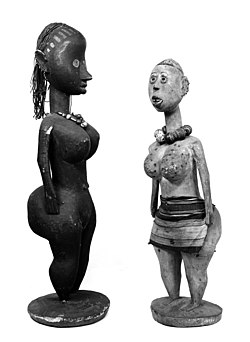West African hunter-gatherers,[1] West African foragers,[2] or West African pygmies[3] dwelled in western Central Africa earlier than 32,000 BP[4] and dwelled in West Africa between 16,000 BP and 12,000 BP[5] until as late as 1000 BP[1] or some period of time after 1500 CE.[6] West African hunter-gatherers are archaeologically associated with the West African Microlithic Technocomplex.[4] Despite its significance in the prehistory of West Africa, the peopling of various parts of Western Africa from the Sub-Saharan regions of coastal West Africa and the forests of western Central Africa often goes overlooked.[7]

Prior to West African hunter-gatherers, there may have been various peoples (e.g., Iwo Eleru people, possibly Aterians) who continuously occupied West Africa amid the Middle Stone Age.[8] Macrolith-using late Middle Stone Age peoples (e.g., the possibly archaic human admixed[9] or late-persisting early modern human[10] Iwo Eleru fossils of the late Middle Stone Age), who dwelled in Central Africa, western Central Africa, and West Africa, were displaced by microlith-using Late Stone Age Africans (e.g., non-archaic human admixed Late Stone Age Shum Laka fossils dated between 7000 BP and 3000 BP) as they migrated from Central Africa, to western Central Africa, into West Africa.[9] Earlier than 32,000 BP,[4] or by 30,000 BP,[5][7] Late Stone Age West African hunter-gatherers were dwelling in the forests of western Central Africa[7][5] (e.g., earlier than 32,000 BP at de Maret in Shum Laka,[4] 12,000 BP at Mbi Crater).[7] Between 16,000 BP and 12,000 BP, Late Stone Age West Africans began dwelling in the eastern and central forested regions (e.g., Ghana, Ivory Coast, Nigeria;[5] between 18,000 BP and 13,000 BP at Temet West and Asokrochona in the southern region of Ghana, 13,050 ± 230 BP at Bingerville in the southern region of Ivory Coast, 11,200 ± 200 BP at Iwo Eleru in Nigeria)[7] of West Africa.[5] West African hunter-gatherers resided at the Nigerian sites of Iwo Eleru and Rop, at the Ivorian site of Bingerville, at the Cameroonian site of Shum Laka, at the Malian site of Ounjougou,[11] and at the Senegalese sites of Fatandi and Toumboura.[12]
Prior to the Holocene era, interaction between West Africans migrating from the Sahara and West African hunter-gatherers of the savanna and forest regions were limited, as evidenced by West African hunter-gatherer microlithic cultural continuity.[13] West African hunter-gatherers likely were the sole occupants of the savanna and forest regions of West Africa.[13] Unlike Central African hunter-gatherers, who dwell in more secluded areas in the forests of Central Africa, West African hunter-gatherers likely dwelt in more open areas of West Africa.[13] Migration of Saharan peoples south of the Sahelian region resulted in seasonal interaction and gradual absorption of West African hunter-gatherers, who primarily dwelt in the savannas and forests of West Africa.[1] After having persisted as late as 1000 BP,[1] or some period of time after 1500 CE,[6] remaining West African hunter-gatherers, many of whom dwelt in the forest-savanna region, were ultimately acculturated and admixed into larger groups of West African agriculturalists, akin to the migratory Bantu-speaking agriculturalists and their encounters with Central African hunter-gatherers.[1]
- ^ a b c d e MacDonald 2003, p. 43–44.
- ^ Lipson, Mark; et al. (2020). "Ancient West African foragers in the context of African population history". Nature. 577 (7792): 665–669. Bibcode:2020Natur.577..665L. doi:10.1038/s41586-020-1929-1. ISSN 0028-0836. OCLC 8545173694. PMC 8386425. PMID 31969706. S2CID 210862788.
- ^ Fanthorpe, Richard (Jul 4, 2013). "Forest Peoples: Sierra Leone, Liberia, Cote d'Ivoire (Ivory Coast): History of to 1800". Encyclopedia of African History. New York London: Routledge. p. 908. doi:10.4324/9780203483862-10. ISBN 9781135456696. OCLC 858902731. S2CID 228146636.
- ^ a b c d MacDonald 1997, p. 192–193.
- ^ a b c d e Scerri, Eleanor M. L. (2021). "Continuity of the Middle Stone Age into the Holocene". Scientific Reports. 11 (1): 70. doi:10.1038/s41598-020-79418-4. OCLC 8878081728. PMC 7801626. PMID 33431997. S2CID 231583475.
- ^ a b Van Beek, Walter E.A.; Banga, Pieteke M. (Mar 11, 2002). "The Dogon and their trees". Bush Base, Forest Farm: Culture, Environment, and Development. Routledge. p. 66. doi:10.4324/9780203036129-10. ISBN 9781134919567. OCLC 252799202. S2CID 126989016.
- ^ a b c d e MacDonald 2003, p. 39–40.
- ^ Niang, Khady; et al. (2020). "The Middle Stone Age occupations of Tiémassas, coastal West Africa, between 62 and 25 thousand years ago". Journal of Archaeological Science: Reports. 34: 102658. Bibcode:2020JArSR..34j2658N. doi:10.1016/j.jasrep.2020.102658. ISSN 2352-409X. OCLC 8709222767. S2CID 228826414.
- ^ a b Schlebusch, Carina M.; Jakobsson, Mattias (2018). "Tales of Human Migration,Admixture, and Selection in Africa". Annual Review of Genomics and Human Genetics. 19: 407. doi:10.1146/annurev-genom-083117-021759. ISSN 1527-8204. OCLC 7824108813. PMID 29727585. S2CID 19155657.
- ^ Bergström, Anders; et al. (2021). "Origins of modern human ancestry". Nature. 590 (7845): 232. Bibcode:2021Natur.590..229B. doi:10.1038/s41586-021-03244-5. ISSN 0028-0836. OCLC 8911705938. PMID 33568824. S2CID 231883210.
- ^ Huysecom, Eric; et al. (2004). "Ounjougou (Mali): A history of Holocene settlement at the southern edge of the Sahara". Antiquity. 78 (301): 589–591. doi:10.1017/S0003598X00113237. ISSN 0003-598X. OCLC 8271919279. S2CID 129493039.
- ^ Chevrier, Benoît; et al. (2020). "New data on settlement and environment at the Pleistocene/Holocene boundary in Sudano-Sahelian West Africa: Interdisciplinary investigation at Fatandi V, Eastern Senegal". PLOS ONE. 15 (12): e0243129. Bibcode:2020PLoSO..1543129C. doi:10.1371/journal.pone.0243129. ISSN 1932-6203. OCLC 9530421458. PMC 7725507. PMID 33296412. S2CID 228088701.
- ^ a b c MacDonald 2003, p. 48–49.
© MMXXIII Rich X Search. We shall prevail. All rights reserved. Rich X Search
